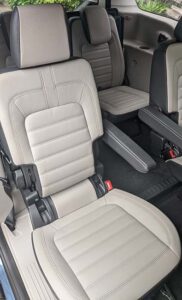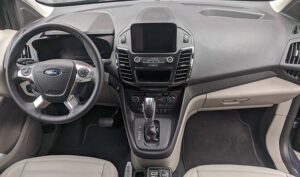2020 Ford Transit Connect passenger van
The test drive of the 2020 Ford Transit Connect wasn’t perhaps my first choice for a booking. A last minute substitution provided the opportunity to review this people mover. 
In all honesty, my daily driver is a a minivan so I was curious to see what this passenger adaptation of a commercial van could offer traditional minivan buyers.
The Ford Transit nameplate has existed in Europe to identify Ford Commercial trucks. The Connect is smaller offering in that category. About a decade ago, Ford replaced the Econoline models with Transit trucks and most recently, Ford Canada has begun offering a 6 or 7 passenger variant of the Transit Connect.
Our test vehicle was a range topping Titanium trim level, a step up from the base level XL and mid level XLT. Visual cues such as chrome trim and 16 inch aluminum wheels help set the Titanium trim level apart from the lower unit that sport steel wheels with plastic wheel covers. The Transit Connect shares enough front end styling cues with the rest of the Ford lineup to be warmly familiar.
The Transit connect features sliding side rear doors with a large lift-gate at the rear. Given the tall roof line and low step up height of the Transit Connect, getting in and out of the vehicle was remarkably easy. Our test vehicle was fitted with middle row captains chairs, which meant room for six passengers. A bench seat can be substituted allowing for 7 passenger seating. 
Visually, the interior revealed a combination of contrasting dark plastics and light seating. A simple yet attractive offering. Closer inspection does reveal somewhat industrial plastics used around the cabin, no doubt a carryover from the workman nature of the origin vehicle. However as noted, the overall look inside the vehicle was pleasant and with extra large windows surrounding the occupants, its a very airy cabin, with great sight lines for the driver. Seating is also quite good, especially for the driver and first two rows of occupants. The third row of seats can slide to create more leg room, just be aware the seats are somewhat thinner on padding and support and longer journeys can be tiring.
Cargo room is variable based on how much room you need for passengers. With all three seats used by passengers, cargo capacity is limited to around 460 litres of storage. With the third row folded down, expect around 1700L and with the middle rows collapsed, the Transit Connect provides around 3000L of storage. One caveat, because the platform is an adapted van and not purpose built for all the minivan tricks of folding seating, the seats don’t fold to create a flat storage floor. Rather, a bit of an undulation is evident. For moving boxes its not and issue, large flat objects may need shimming.
The 2020 Transit Connect is powered by a naturally aspirated 2.0L four cylinder gasoline engine, producing 162HP (6500 RPM) and 144 lb-ft of torque (4500 RPM). The engine is mated to an 8 speed automatic gearbox that provides surprisingly effective shift points and spirits the van to 100 kms per hour in around 10 seconds. With the normally aspirated 2.0L engine, Ford rated the Transit Connect to tow up to 2,000 lbs.
On the road, the Transit Connect was surprisingly nimble. The suspension effectively soaked up most road obstacles without feeling mushy and the and surely reflects its European origins. The sure footed handling was due in no small part to the addition of torque vectoring stability control. Part of the system can detect cross winds and adapt the van’s ride and handling. Adaptive cruise control was also included in our tester.
Whether is was highway miles or city navigating, the Transit Connect’s handling could definitely be described as car-like. From the responsive steering to the pliant suspension or effective brakes, the Transit Connect scored high marks for driving ease.
As opposed to the bulk of passenger vans on the market, the Transit Connect offered excellent fuel economy of around 9L per 100 kms of travel. The four cylinder engine may lack the punch of other models powered with a V6 engine close to twice the size, but in the current environment of surging fuel prices, the smaller engine does have its rewards.
Perhaps the most noticeable downside of the Transit Connect as a minivan substitute comes when comparing passenger amenities. The Ford van tended to offer basic amenities such as cup holders for all but limiting climate controls and charging outlets to second row passengers. Audio video systems were also absent. That being said, the Titanium edition Connect features an AM/FM/Satellite head unit featuring Ford’s SYNC system with Apple CarPlay and Google’s Android Auto and a wireless charging pod. An onboard navigation system, with a 6.5 inch LCD screen, is standard on the Titanium edition.
Pricing for the 202 Ford Transit Connect pushes it squarely into the minivan market. The main strong points for the Ford Transit Connect are handling, fuel economy and ease of driving.
At the time of testing the list price for 2020 Ford Transit Connect Titanium was $38,025, the price as tested was $44,844. Extras included on the tester were: panoramic sunroof, ($1,750), remote start ($350), an Engine block heater ($100), adaptive cruise control ($784), active park assist ($1,000), a trailer tow hitch ($425), flex fuel system ($150) and a Quickclear windshield defroster with thin wires planted in the glass ($260).
Copyright © Auto Reviews Online 2016 | Privacy & Terms of Use | info@autoreviewsonline.com | Website by Brolly Media
